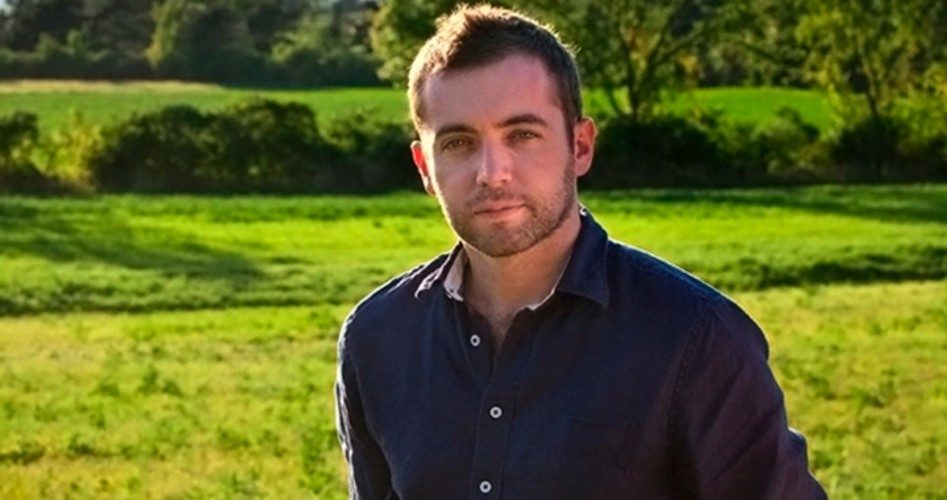
Weeks after the fiery death of investigative journalist Michael Hastings (shown), who was probing abuses by the CIA and NSA and had recently informed others that he was being investigated by federal authorities, suspicions about his mysterious car crash are still swirling around the Internet. While police officially ruled the death an “accident,” serious questions are still surfacing — even in the establishment media and among prominent officials. Based on e-mails Hastings sent out shortly before he died about working on a “big story” and needing to go “off the radar,” it has become clear that he was worried, too.
Hastings, who wrote for Rolling Stone, BuzzFeed, Gawker, and other publications, was probably best known for his award-winning 2010 article “The Runaway General.” The piece helped bring down U.S. Gen. Stanley McChrystal, commander of American and NATO forces in Afghanistan. Despite his establishment credentials and what analysts called his “Democrat-friendly” reporting, Hastings had become extremely alarmed about the “surveillance state” and other troubling developments in recent months. His last published story: “Why Democrats Love To Spy On Americans.”
When the Obama administration was exposed spying on journalists earlier this year, the investigative reporter blasted what he referred to as the president’s “war” on journalism. “The Obama administration has clearly declared war on the press. It has declared war on investigative journalists — our sources,” he said during a recent TV interview, blasting the administration’s lawless behavior, obsession with secrecy, and vicious persecution of whistleblowers. Beyond simple criticism, though, Hastings openly said it was time for journalists to fight back.
“I think the only recourse to this kind of behavior by the government is to say back to the government, ‘we declare war on you,’ and from this point forward, we should no longer — the media as a whole — cooperate in any manner with the government,” he continued. “We should withdraw all our cooperation and we should publish everything we know, because it’s a free press, it’s not a free-except-for-when-the-government-tells-me-to-do-it press, and we’ve been way too easygoing with these guys.”
Less than 24 hours before his death, Hastings made it crystal clear that he was concerned about his own well-being. In an e-mail sent to numerous contacts and his employer, for example, Hastings noted: “The Feds are interviewing my ‘close friends and associates.’” He also said that if authorities show up, it “may be wise to immediately request legal counsel before any conversations or interviews about our news-gathering practices or related journalism issues.” The subject line read: “FBI investigation re: NSA.” Perhaps most alarming of all, the e-mail concluded with this: “Also: I’m onto a big story, and need to go off the rada[r] for a bit.”
While some friends and family members are reportedly too frightened to speak out, at least one recipient of the e-mail has gone public. Staff Sgt. Joseph Biggs, who became friends with Hastings while the journalist was embedded with his unit in Afghanistan in 2008, told KTLA that the “very panicked” message “alarmed me very much.” According to Biggs, “I just said it doesn’t seem like him. I don’t know, I just had this gut feeling and it just really bothered me.”
Biggs has spoken to Fox News and other major media outlets as well, saying Hastings was working on “the biggest story yet” about the CIA and that Hastings’ wife vowed to “take down whoever did this.” Apparently Hastings “drove like a grandma.” In an extended interview with radio host Alex Jones, Biggs also said he knew Hastings was receiving “death threats” from military brass. The retired staff sergeant added that he was extremely suspicious about his friend’s death and vowed to do everything in his power to find out what happened.
Heavy-hitters from the government sector have expressed concerns, too. Former U.S. National Coordinator for Security, Infrastructure Protection, and Counter-terrorism Richard Clarke, for example, told The Huffington Post in late June that the deadly car crash was “consistent with a car cyber-attack.” Intelligence agencies for major powers — including the U.S. government — almost certainly know how to remotely seize control of a car, he added.
“What has been revealed as a result of some research at universities is that it’s relatively easy to hack your way into the control system of a car, and to do such things as cause acceleration when the driver doesn’t want acceleration, to throw on the brakes when the driver doesn’t want the brakes on, to launch an air bag,” Clarke continued. “You can do some really highly destructive things now, through hacking a car, and it’s not that hard…. So if there were a cyber-attack on the car — and I’m not saying there was — I think whoever did it would probably get away with it.”
So far, the FBI has denied that it was investigating Hastings. However, on June 19, the day after the mysterious crash, WikiLeaks released what has been interpreted as a bomb-shell to some analysts monitoring the investigation. “Michael Hastings contacted WikiLeaks lawyer Jennifer Robinson just a few hours before he died, saying that the FBI was investigating him,” the whistleblowing organization said through its official Twitter account, sparking worldwide press coverage. The allegation has not been independently confirmed.
According to the official investigation of the crash, Hastings ran a red light and was driving over 100 miles per hour in his brand-new Mercedes in the early morning when he suddenly crashed into a tree, causing his car to burst into a bizarre fiery inferno. The engine was found more than 150 feet from the wreck. Local news outlets in California, meanwhile, are reporting that the police report is still not publicly available and that officials have been ordered not to comment on the case. The crash itself has also been ringing alarm bells among experts and analysts.
On San Diego 6 News, national security reporter Kimberly Dvorak, for example, recently took to the air and talked about her conversations with sources surrounding the crash after spending a day in Los Angeles investigating. Noting that the police report was not available, she said law enforcement and fire department officials refused to comment, with some saying they had been instructed not to say anything. “That kind of stands out; we look at the NSA, the government says if you have nothing to hide, don’t worry,” she said.
Military officials, meanwhile, told Dvorak that the fire was “extremely hot” and “not something we normally see,” the reporter continued. The fact that the engine was between 150 and 250 feet behind the car was also strange, according to university physics professors she spoke with — it should have been in front, if anything. Another interesting fact highlighted in the report: There were no skid marks at the accident scene.
Mercedes, she added, insists that their cars do not blow up. In fact, the company has a reputation for building some of the safest cars in the world, but Mercedes has not yet been contacted by authorities, according to a statement. Citing a 2010 study from a California university, Dvorak also noted that it is possible to “hack into the car system and operate the accelerator, the brakes, windshield wipers, light, steering,” and more using a simple iPad.
Car experts have also expressed skepticism about the official narrative. “I’m here to state that I’ve seen dozens of cars hit walls and stuff at high speeds and the number of them that I have observed to eject their powertrains and immediately catch massive fire is, um, ah, zero,” noted Jack Baruth, editor of The Truth About Cars. “Modern cars are very good at not catching fire in accidents. The Mercedes-Benz C-Class, which is an evolutionary design from a company known for sweating the safety details over and above the Euro NCAP requirements, should be leading the pack in the not-catching-on-fire category.”
“Nor is the C-Class known for sudden veering out of control into trees and whatnot,” continued Baruth, who has a professional racing license as well. “Mr. Hastings’ aggressively Democrat-friendly storytelling has the Internet already considering the idea that his death was engineered somehow. I can’t say it’s totally unlikely. As noted above, the reported (and videotaped) behavior of the C250 was not in line with what we’d expect.”
It would not be the first time that a prominent journalist taking on the establishment has died under suspicious circumstances. Conservative-leaning alternative-media giant Andrew Breitbart, for example, promised to reveal information that would destroy the Obama machine. Shortly before the highly anticipated release, the 43-year-old died of “heart failure.” Two months later, the county coroner who conducted Breitbart’s autopsy was poisoned. Before that, investigative journalist Gary Webb, who exposed CIA cocaine trafficking, supposedly “committed suicide” with two bullets to the head after publicly expressing his concerns that he would be killed. The list could go on.
Of course, it is now common knowledge that the administration believes it can extra-judicially murder anyone — including Americans — whom Obama claims is a threat to the “Homeland.” No charges or trial are required, and indeed, the president has already openly murdered Americans like Anwar al Awlaki and his young son without even charging them with a crime — let alone securing a conviction by a jury in a court of law. Whether Hastings was murdered remains uncertain, but there is little doubt that the circumstances of his death were extremely suspicious.
Photo of Micheal Hastings: AP Images
Alex Newman is a correspondent for The New American, covering economics, politics, and more. He can be reached at [email protected].



